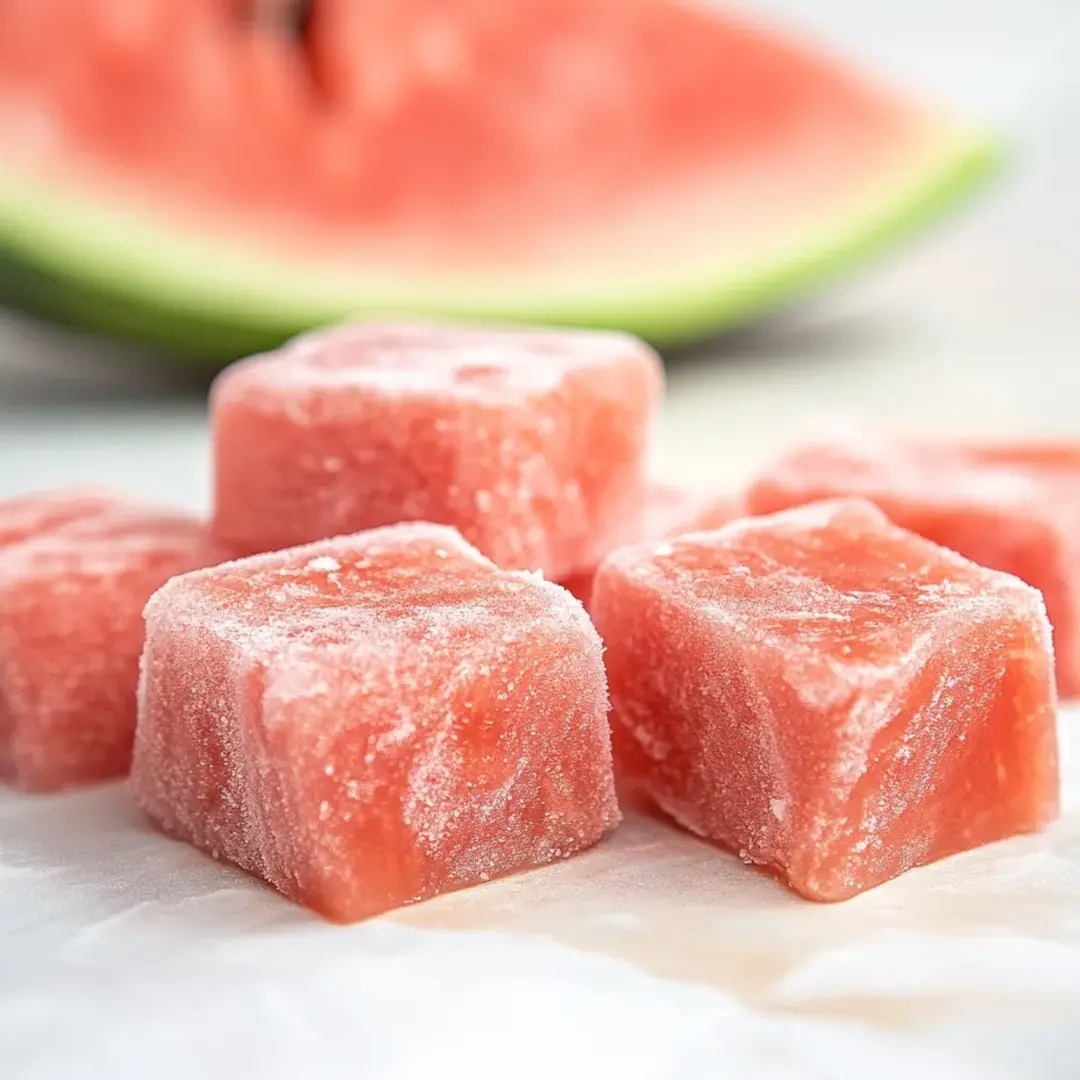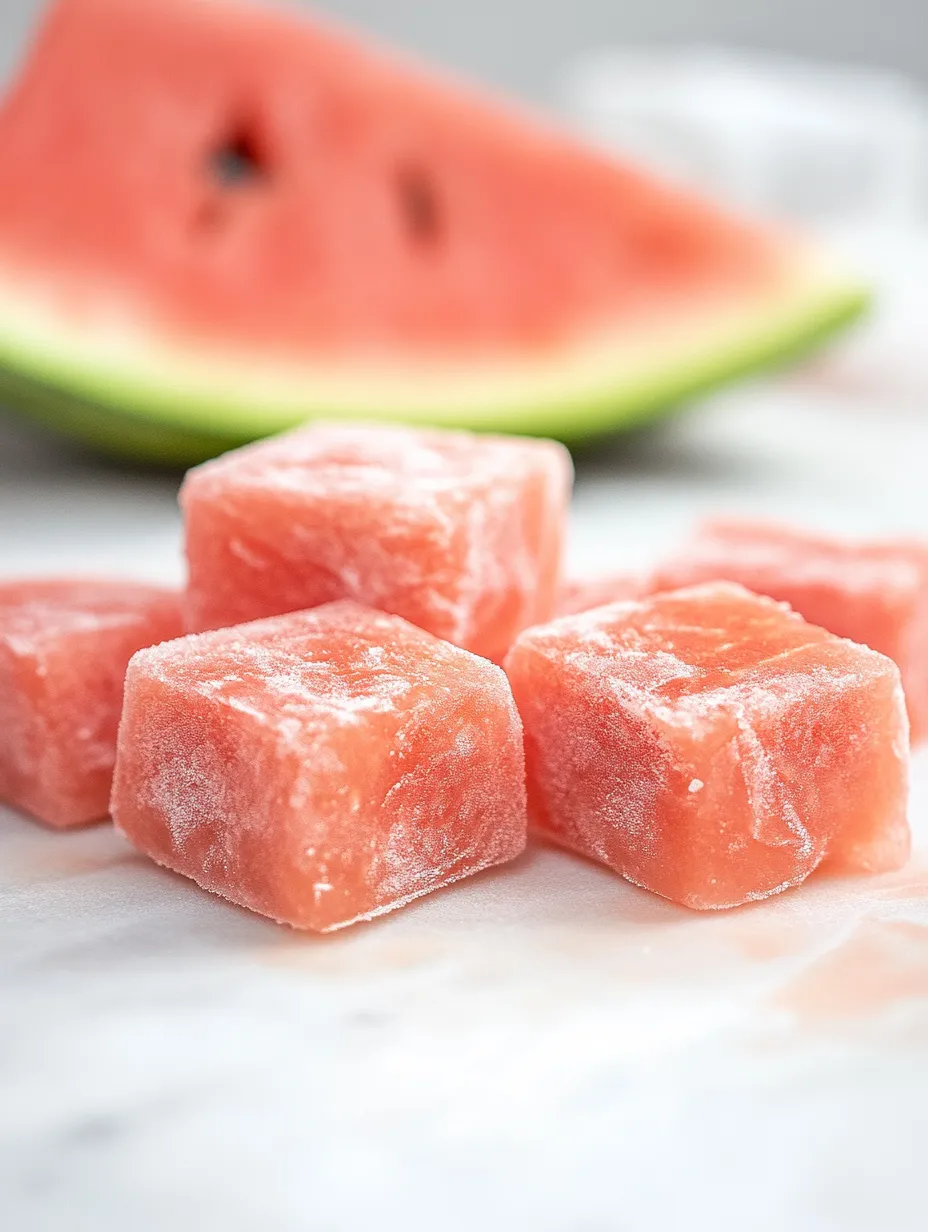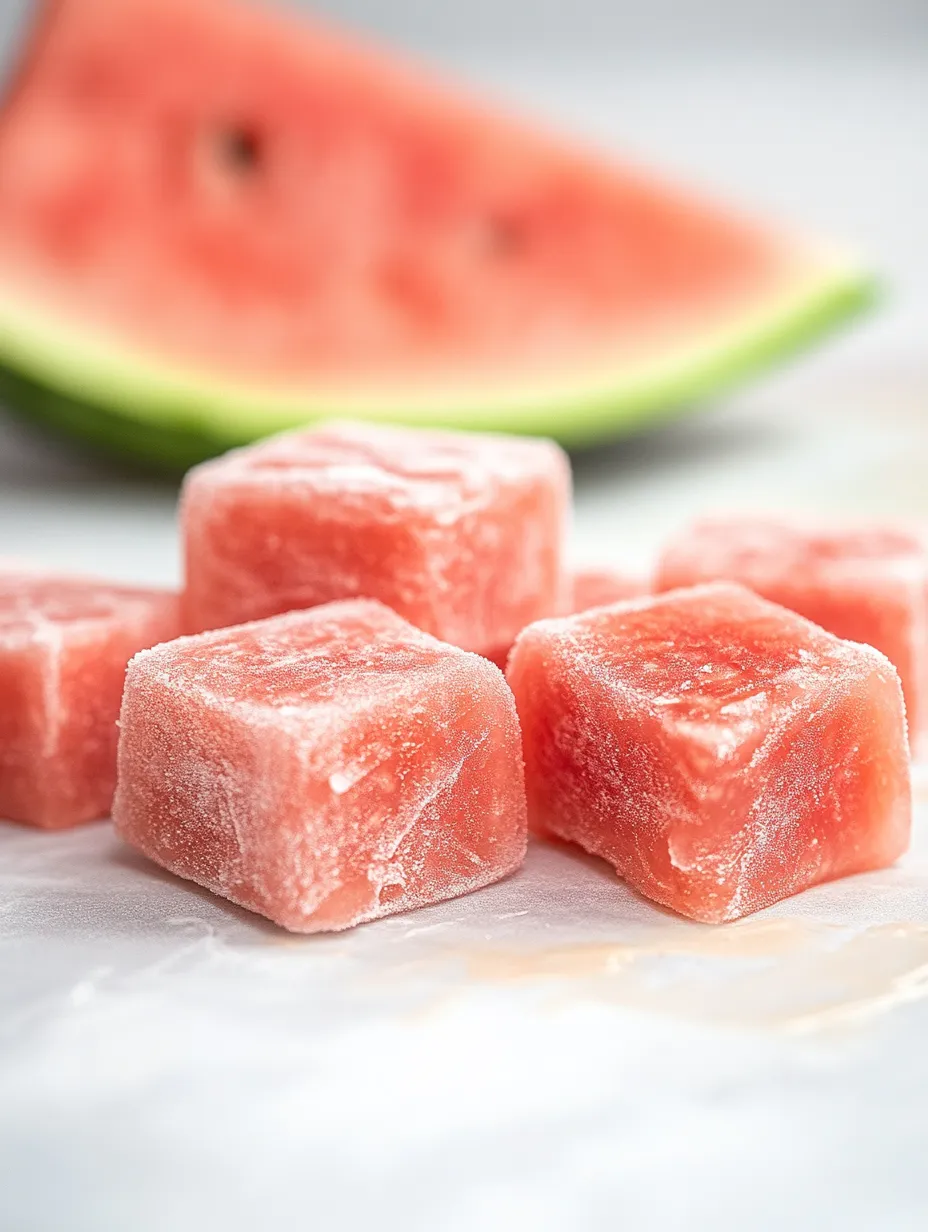 Pin it
Pin it
Watermelon Mochi delivers a uniquely refreshing twist on traditional Japanese rice cake treats. These soft, chewy squares combine the subtle sweetness of fresh watermelon with the distinctive bouncy texture that makes mochi so irresistible. The delicate pink hue and fruity essence create a dessert that's not only visually appealing but also perfectly captures summer's most beloved fruit in an unexpected form. Perfect for warm weather gatherings or as a light dessert after a meal, this watermelon mochi brings something special to your table that most people have never experienced before.
I was skeptical about watermelon in mochi the first time I tried making it, wondering if the flavor would even come through. But after that first bite, I was completely sold! There's something magical about how the subtle watermelon essence complements the chewy texture – my niece now requests these "pink pillows" every time she visits during summer.
Ingredients
- Glutinous rice flour: The essential ingredient for creating that signature chewy mochi texture; look for Thai elephant brand or other glutinous rice flour (not regular rice flour)
- Fresh watermelon: Provides both flavor and natural coloring; choose a ripe, sweet watermelon for best results
- Granulated sugar: Enhances and balances the natural watermelon sweetness; adjust based on how sweet your watermelon is
- Cornstarch: Helps with texture and prevents sticking; both in the dough and for dusting
- Vegetable oil: Creates a smoother texture and helps prevent sticking during cooking
- Additional cornstarch or potato starch: For dusting the finished mochi to prevent sticking
 Pin it
Pin it
Cooking Instructions
- Step 1:
- Prepare fresh watermelon juice - Start with a ripe, sweet watermelon for the best flavor. Cut the watermelon into chunks, removing any seeds. Blend the chunks in a blender until completely liquefied. Pour the blended watermelon through a fine-mesh sieve to remove any pulp or remaining seeds, pressing gently with a spoon to extract all the juice. You'll need about 1 cup of strained watermelon juice for this recipe. The fresher the juice, the better the flavor will be in your final mochi, so it's best to prepare this right before making the recipe rather than using juice that's been sitting in the refrigerator.
- Step 2:
- Mix the dry ingredients thoroughly - In a medium mixing bowl, whisk together 1 cup glutinous rice flour, 1/4 cup granulated sugar, and 2 tablespoons cornstarch until well combined. Breaking up any lumps at this stage is important for a smooth mochi texture. If your watermelon is particularly sweet, you can reduce the sugar slightly, but don't eliminate it completely as it helps with both flavor and texture. Make a well in the center of your dry ingredients to prepare for adding the wet ingredients.
- Step 3:
- Create the mochi batter - Pour 1 cup of the strained watermelon juice into the well of dry ingredients. Add 1 tablespoon of vegetable oil. Using a whisk or rubber spatula, gradually incorporate the dry ingredients into the juice, starting from the center and working outward, until a smooth pink batter forms with no lumps. The batter should have a consistency similar to pancake batter – not too thick or too thin. If the batter seems too thick, add a little more watermelon juice, one tablespoon at a time. If it's too thin, add a bit more glutinous rice flour.
- Step 4:
- Cook the mochi properly - Transfer the batter to a microwave-safe bowl that's large enough to allow the mixture to expand while cooking. Cover it loosely with plastic wrap, leaving a small vent for steam to escape. Microwave on high for 1 minute, then remove and stir well with a wet rubber spatula or wooden spoon. The mixture will be partially cooked and starting to solidify. Cover again and microwave for another minute, then stir. Repeat this process one or two more times until the mochi is translucent and has a sticky, stretchy consistency. The total cooking time should be about 3-4 minutes, depending on your microwave's power. Alternatively, if you prefer to cook on the stovetop, pour the batter into a non-stick pot and cook over medium-low heat, stirring constantly until the mixture thickens and becomes translucent (about 5-8 minutes).
- Step 5:
- Shape and serve the mochi - Prepare a work surface by generously dusting it with cornstarch or potato starch. Using a wet spatula or oiled hands, transfer the hot mochi mixture onto the prepared surface. Dust the top with more starch to prevent sticking. Allow the mochi to cool just enough to handle it safely, but work with it while it's still warm for the best texture. Using a bench scraper or knife dusted with starch, cut the mochi into 1-inch squares or shape into balls if preferred. Roll each piece in additional starch to prevent sticking, then gently shake off any excess. Serve immediately for the best texture and flavor, or store in an airtight container at room temperature for up to 24 hours.
I especially love how the watermelon flavor in this mochi is subtle yet unmistakable. It's not an overwhelming artificial watermelon taste, but rather a delicate hint of fresh fruit that pairs perfectly with the chewy texture. My family was initially surprised by the combination, but now they specifically request "watermelon mochi" during summer gatherings—it's become our signature seasonal treat!
Perfect Mochi Texture Tips
Achieving the ideal mochi texture—soft, chewy, and not too sticky—requires attention to a few key details. First, measuring your ingredients accurately is crucial; glutinous rice flour absorbs liquid differently depending on the brand, so be prepared to adjust slightly. Second, don't skimp on the kneading process after cooking. Even though the mixture will be hot, proper kneading develops the characteristic chewiness that makes good mochi so satisfying.
If your mochi turns out too hard, it was likely overcooked or contains too little liquid. On the other hand, if it's excessively sticky, you probably need more starch for dusting or slightly less liquid in the mixture. Remember that freshly made mochi has the best texture—it will naturally become firmer as it sits, especially if refrigerated.
 Pin it
Pin it
Creative Serving Ideas
While these watermelon mochi squares are delicious on their own, there are several ways to elevate them for special occasions. Try serving them alongside small cubes of fresh watermelon for a textural contrast that emphasizes the fruit flavor. For a more substantial dessert, pair warm mochi with a scoop of vanilla ice cream or coconut sorbet.
For presentation, consider arranging the pink mochi squares in a pattern resembling watermelon slices on a dark plate, perhaps with a sprinkle of black sesame seeds to mimic watermelon seeds. At summer gatherings, serve them on a platter with other fruit-inspired treats for a colorful dessert spread that highlights seasonal flavors.
Flavor Variations
Once you've mastered the basic watermelon mochi, consider experimenting with variations. Add a teaspoon of lime zest to the batter for a watermelon-lime version that offers a citrusy twist. For a more intense watermelon flavor, reduce some watermelon juice by simmering it gently until slightly thickened before adding it to your recipe.
You can also adapt this technique to other summer fruits. Try substituting strawberry puree, cantaloupe juice, or even peach nectar for the watermelon juice. Each variation brings its own unique flavor profile while maintaining that satisfying chewy texture that makes mochi so special.
There's something magical about the way watermelon mochi captures the essence of summer in each bite. The delicate pink color, subtle fruity sweetness, and satisfyingly chewy texture create a treat that's both familiar and surprising. What began as an experiment with seasonal fruit has become one of my favorite ways to celebrate watermelon season. Whether you're a longtime mochi enthusiast or trying it for the first time, this watermelon version offers a refreshing twist that proves traditional recipes can evolve in delightful and unexpected ways.
Frequently Asked Questions
- → How long does watermelon mochi stay fresh?
- These mochi squares are best consumed within 1-2 days. Store them in an airtight container at room temperature with plenty of cornstarch to prevent sticking. Do not refrigerate as this will harden the mochi.
- → Can I use other fruit juices instead of watermelon?
- Yes, this recipe works well with other fruit juices like strawberry, mango, or honeydew. Just make sure to strain the juice well to remove any pulp for the best texture.
- → Where can I find glutinous rice flour?
- Glutinous rice flour (also called sweet rice flour) can be found in most Asian grocery stores, in the international aisle of well-stocked supermarkets, or online. Popular brands include Mochiko and Erawan.
- → Why is my mochi too sticky?
- If your mochi is too sticky to handle, you need more cornstarch. Be generous with the cornstarch dusting on all surfaces of the mochi. You can also try lightly oiling your knife and hands when handling.
- → Can I freeze watermelon mochi?
- Yes, you can freeze mochi for up to one month. Wrap each piece individually in plastic wrap and store in an airtight container. Let them thaw at room temperature for about 30 minutes before eating.
